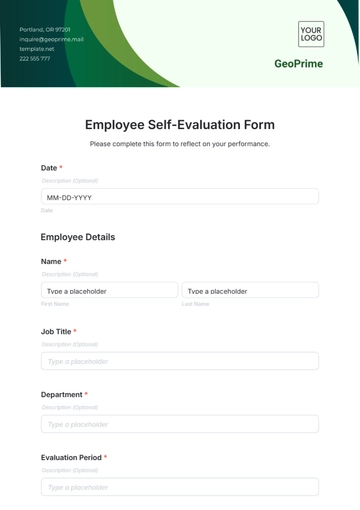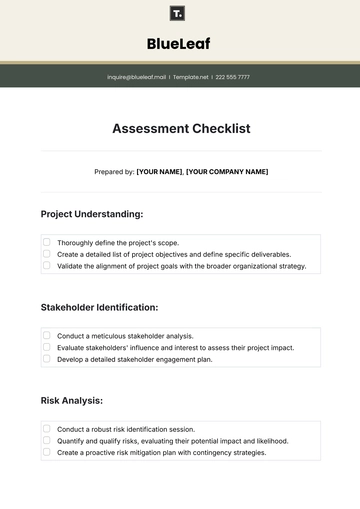Free Biodiversity Risk Assessment

Project Name: Road Construction Project - Green Valley Road Extension
Date of Assessment: December 2, 2055
Location: Green Valley, Riverwood Forest, near Nature Reserve 45
Prepared by: John Doe, Environmental Consultant
Review Date: December 15, 2055
1. Project Overview
Project Description:
The Green Valley Road Extension aims to improve accessibility to rural areas by expanding a 5-kilometer stretch of road through Riverwood Forest. The construction will involve land clearing, grading, and the creation of supporting infrastructure such as bridges and drainage systems.Project Duration:
Start Date: January 2055
End Date: December 2055Location and Habitat Description:
The project is located in a temperate forest ecosystem characterized by dense coniferous and deciduous trees. The area is home to several wildlife species and provides vital ecosystem services, including water filtration for the nearby Riverwood River.
2. Identification of Key Biodiversity Features
Species of Concern:
Riverwood Wolf (Canis lupus riverwoodensis) - A subspecies listed as endangered, with fewer than 200 individuals remaining in the region.
Eastern Spotted Owl (Strix occidentalis occidentalis) - A species of special concern, frequently nesting in the forested areas impacted by the road.
Habitats of Importance:
The project area overlaps with the Riverwood Wetlands, a vital habitat for migratory bird species such as the Great Egret and Canada Goose.
Riparian Zones along the Riverwood River support aquatic biodiversity including the Riverwood Trout (Salmo trutta riverwoodensis).
Ecosystem Services:
Water Purification – The forest and wetland areas filter runoff and maintain water quality for the surrounding community.
Carbon Sequestration – The forest acts as a significant carbon sink, helping mitigate the region's greenhouse gas emissions.
Protected Areas and Conservation Zones:
Nature Reserve 45 is located 2 kilometers from the construction site and is a designated protected area to safeguard native flora and fauna.
3. Potential Impacts on Biodiversity
A. Direct Impacts:
Habitat Destruction/Fragmentation:
Road construction will directly fragment the forest, impacting wildlife movement, particularly the Riverwood Wolf, which requires large, continuous tracts of land to maintain territory. This could disrupt mating patterns and hunting behaviors.
Pollution:
Chemical runoff from construction activities may contaminate local water bodies, potentially affecting species like the Riverwood Trout and aquatic plants.
Noise Pollution from heavy machinery and construction vehicles may disturb sensitive species such as the Eastern Spotted Owl and other wildlife, causing displacement.
Invasive Species:
The construction activities could introduce invasive plant species like Japanese Knotweed (Fallopia japonica), which may outcompete native plants and affect the local herbivorous insect populations that support the food web.
Wildlife Disturbance:
Riverwood Wolves could be displaced from their habitat during construction, and increased human activity could disrupt their hunting grounds, leading to food scarcity and increased human-wildlife conflict.
B. Indirect Impacts:
Climate Change:
Construction could lead to the loss of forest cover, decreasing carbon sequestration capacity, and contributing to regional climate warming, affecting local plant and animal species.
Human-Wildlife Conflicts:
Increased human presence and road traffic could lead to more encounters between wildlife and humans, particularly with Riverwood Wolves and Eastern Spotted Owls, increasing the risk of roadkill.
4. Risk Level Assessment
Impact | Severity (1-5) | Likelihood (1-5) | Risk Level (Severity x Likelihood) |
|---|---|---|---|
Habitat Destruction | 5 | 4 | 20 (Very High Risk) |
Pollution | 4 | 3 | 12 (High Risk) |
Invasive Species | 3 | 3 | 9 (Moderate Risk) |
Wildlife Disturbance | 4 | 4 | 16 (High Risk) |
Climate Change | 4 | 2 | 8 (Moderate Risk) |
Human-Wildlife Conflict | 3 | 4 | 12 (High Risk) |
5. Mitigation Measures
Identified Impact | Mitigation Measure | Responsibility | Timeline |
|---|---|---|---|
Habitat Destruction | Implement wildlife corridors and minimize habitat fragmentation by adjusting the road design. | Project Manager | During Design |
Pollution | Use silt fences, sedimentation basins, and buffer zones to prevent runoff into water sources. | Environmental Officer | During Construction |
Invasive Species | Regularly monitor the area for invasive species and implement removal strategies. | Ecologist | Ongoing |
Wildlife Disturbance | Schedule construction activities outside of peak breeding seasons and use noise barriers. | Construction Manager | Ongoing |
Climate Change | Reduce deforestation by optimizing road alignment to avoid critical forest areas. | Project Manager | During Design |
Human-Wildlife Conflict | Install wildlife warning signs and fencing along roadways, particularly in areas near wolf territories. | Safety Officer | Construction Phase |
6. Monitoring and Reporting
Monitoring Plan:
Monitor water quality in nearby rivers and streams bi-monthly for chemical contaminants.
Use wildlife cameras and tracking to monitor the movement and health of endangered species like the Riverwood Wolf.
Conduct regular site visits to assess the health of ecosystems and vegetation restoration.
Reporting Protocol:
Quarterly reports will be submitted to the local environmental authorities and the Nature Reserve Management Committee.
A final biodiversity impact assessment will be provided after the project.
7. Stakeholder Engagement
Consultation Process:
Consultation with local conservation groups such as the Riverwood Wildlife Trust and Eastern Owl Protection Society has been conducted to discuss concerns and gather input.
Public consultations will be held in local communities to address concerns and provide updates on the project's environmental impacts.
Public Participation:
A community feedback mechanism will be established to gather input from residents and stakeholders regarding wildlife impacts and mitigation effectiveness.
8. Conclusion
The Green Valley Road Extension, set to begin in 2055, presents significant biodiversity risks, particularly to endangered species and critical habitats in the Riverwood Forest area. However, the implementation of mitigation measures such as wildlife corridors, pollution controls, and seasonal construction scheduling will help minimize these impacts. Continuous monitoring and stakeholder engagement are essential to ensure that the project proceeds with minimal disruption to the local ecosystem.
- 100% Customizable, free editor
- Access 1 Million+ Templates, photo’s & graphics
- Download or share as a template
- Click and replace photos, graphics, text, backgrounds
- Resize, crop, AI write & more
- Access advanced editor
The Biodiversity Risk Assessment Template from Template.net helps evaluate environmental impacts on biodiversity. Fully editable and customizable, it enables you to tailor the template to your specific needs. Use our AI Editor Tool for easy adjustments and ensure your risk assessment addresses the key factors affecting biodiversity conservation efforts.





























